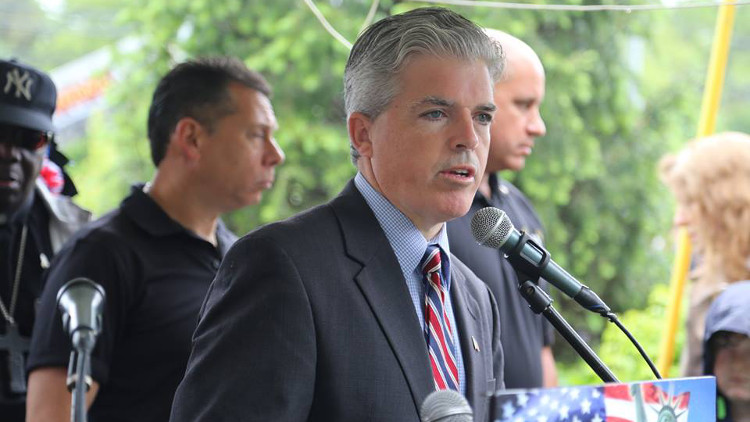From the crowded podium at an outdoor press conference in Yaphank last month, backed by a supportive chorus of environmentalists, bureaucrats, civic leaders and elected officials, Suffolk County Executive Steve Bellone announced his method of corralling his public water enemy No. one: nitrogen.
The answer? A small, modest fee on water usage, which according to Newsday, would require “state legislation to allow voters to decide whether they want to create a water quality protection fee of $1 per 1,000 gallons of water used.”
With an estimated annual revenue of nearly $75 million, the new money stream would funnel into a “Water Quality Improvement Fund” with the sole purpose of paying for wastewater improvements, including hooking residences and other assorted areas to sewer plants as well as giving homeowners the opportunity to get septic system upgrades.
Creating new taxes for the sake of water protection is a sound idea, and it has ample policy precedent, for such a model has been used before to help fund open space acquisitions for decades. Further, according to Bellone’s statement, it has been employed in Spokane, Wash., which similarly relies on a sole source aquifer for drinking water.
Despite these positive factors, the motives of the administration behind these actions aren’t sincere. In the end, the proposed new water fee isn’t as much about protecting the environment as it is to create more development opportunities for the real estate industry. The solutions offered by the county’s water protection plan aren’t substantive enough. Essentially, the document’s main approach to water protection focuses on sewers, and their relative effectiveness in achieving nitrogen reduction—a faulty foundation on which to build environmental policy thanks to the limited effectiveness these facilities have had on Long Island.
Regardless of the intentions behind imposing the fee, the call for a referendum on the issue is a brilliant political move. At the ballot box, time and time again Long Islanders have overwhelmingly supported environmental issues related to water protection, so the measure is likely to pass easily. What is most concerning, though, is that many voters who may give their approval won’t realize the ramifications.
Newsday’s Editorial Board, typically gung-ho for such environmental actions, wrote a cautious April 29 editorial that called for additional analysis of the proposal, saying that “the plan lacks details.” They advocated for slowing down what they saw as a rushed process. The editorial board was right, but they didn’t go far enough. The reason why the process is being sped up is because the county executive is eager to put shovels in the ground. The paper should have dug deeper into the linkage between the supposed environmental actions of the administration, and Bellone’s strong desire to build, build, build.
The true ideological roots of this new fee can be traced back to the latest iteration of Suffolk County’s Comprehensive Water Resources Management Plan. Buried within that document in Section 8, the plan tellingly calls for ways to “stimulate development in order to promote economic growth and stability.”
This bureaucratic code translates into the creation of sewers, which, in turn, allows for more developmental density. Advocates for downtown Smithtown and Kings Park are already chomping at the bit for wastewater treatment, having wanted sewer linkages for decades to jumpstart their lagging economic development efforts.
Curbing the nitrogen issue is one thing, but looking to ramp up developmental efforts at the same time is disingenuous. Simply put, jumpstarting LI’s anemic economy shouldn’t be the burden of environmental policy. They should be mutually exclusive efforts with interconnected goals. Economic development can be achieved without adversely impacting the environment, but the Island’s elected officials just haven’t achieved the right balance to achieve it yet.
The bigger issue, however, is can we trust the county with this additional $75 million flowing into its coffers every year? The notion of taxing the water we drink is like taxing the air we breathe in the view of veteran policymakers like Paul Sabatino, a former deputy county executive who previously sued the county over misappropriation of the existing quarter-cent sales tax that already funds Suffolks’s Drinking Water Protection Program. Given recent legal happenings with the county’s clean water fund, residents have the right to be suspicious about Suffolk using the fee for the purpose it is intended. For all intents and purposes, Bellone has not earned that trust back just yet.
Karl Grossman, a veteran award-winning investigative reporter, is also concerned about how much of the water fee is tied to the county’s push for sewers.
“Bellone has been promoting sewering in Suffolk County largely for economic development reasons,” Grossman recently told me. “He feels sewers would be a huge incentive in encouraging development and financial stimulation that he sees coming as a result. Thus, questions have been raised over how much of the sewer push is being made under the guise of environmental protection and also about the impacts of widespread new sewering.”
Grossman argued that existing limitations on growth will likely disappear with additional sewering, much to the delight of the development community. As Grossman put it to me, this is “something the bulldozer boys who have ravaged and paved over so much of western Long Island and now have their eyes on its east and areas of moderate growth in western Suffolk would love to see.”
In fairness to the Bellone administration, LI does have a serious nitrogen problem in its ground and surface waters. As evidenced by the almost annual algae blooms and fish kills, it has gotten worse. At least the county executive is trying to take tangible action to reverse the decline. Run-off from Suffolk’s mostly outdated 360,000 cesspools and septic systems does pollute our water quality, but connecting these properties to sewage treatment should be separate from efforts to develop unsewered downtowns and parcels.
“The good element about the plan,” observed Grossman, “is that it, in part, pays attention to advanced wastewater treatment systems—systems for single homes and communities that utilize new technology now used in areas all over the US in removing nitrogen from wastewater. With nitrogen being the key cause of brown tides, red tides and the deterioration of our waters, these new systems would be ideal for Suffolk County.”
In the press release announcing the proposal, development-friendly groups offered their support alongside local environmental groups. In the developer cohort, Desmond Ryan of the Association for a Better Long Island, a pro-business lobbying group, said the fee is all about reconciling growth and water quality, saying that “striking that balance between environmental protection and comprehensive economic development will only assist in making Suffolk County a great place to do business.”
To Grossman, this sewer talk is déjà vu all over again.
“As a reporter, I covered the Southwest Sewer District project of the 1970s—pushed by construction, engineering and development interests—and it also was claimed to be needed for environmental reasons,” he said. “It became a $1 billion scandal.”
And, he pointed out, that staggering sum represented the value of the dollar back then. Tellingly, the federal government paid 80 percent of the cost, a totally unlikely prospect today.
Bellone’s proposal would be a decent solution if his administration had pure intentions—and if the public could trust that the funding would be spent as promised. If the referendum is eventually approved, the fee would take effect in 2018.
Ideally, the $75 million in annual revenue should only be allocated to help homeowners in decidedly residential, single-family subdivisions convert their existing systems to sewers. But if the water fee doesn’t win the public’s affection, perhaps with the cheap debt available in today’s market, the county should consider just bonding the expected $9 billion it would take to construct the needed sewers.
But the current proposal is purposely vague about what limitations it might impose on the fee’s uses. What’s to prevent it from quickly becoming a slush fund for the politically connected, and in the long run, help contribute to the further decline of Long Island’s drinking and surface waters by overdevelopment? Nobody wants that, at least officially. But in Suffolk these days, it seems that the desire to conduct business is trumping doing what’s needed to protect our threatened aquifer.
Rich Murdocco writes about Long Island’s land use and real estate development issues. He received his Master’s in Public Policy at Stony Brook University, where he studied regional planning under Dr. Lee Koppelman, Long Island’s veteran master planner. Murdocco is a regular contributor to the Long Island Press. More of his views can be found on TheFoggiestIdea.org or follow him on Twitter @TheFoggiestIdea.

































